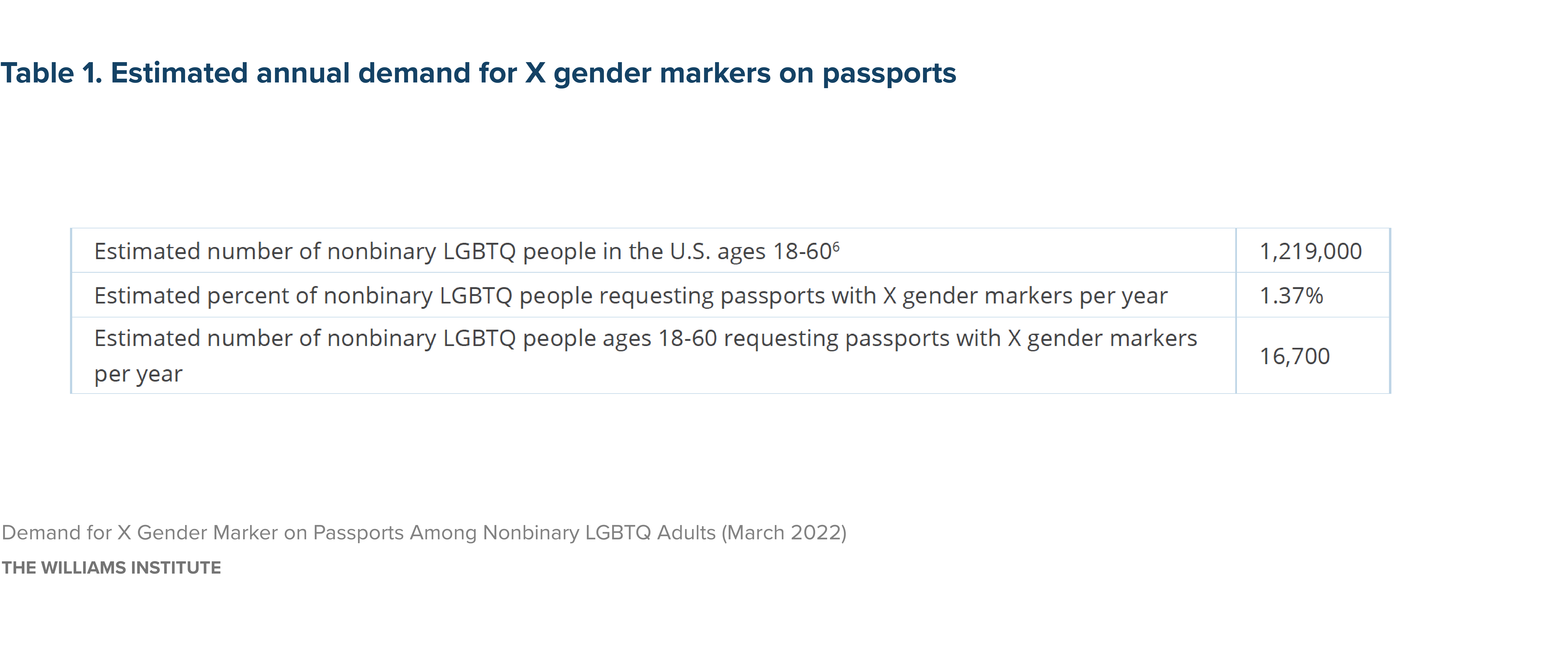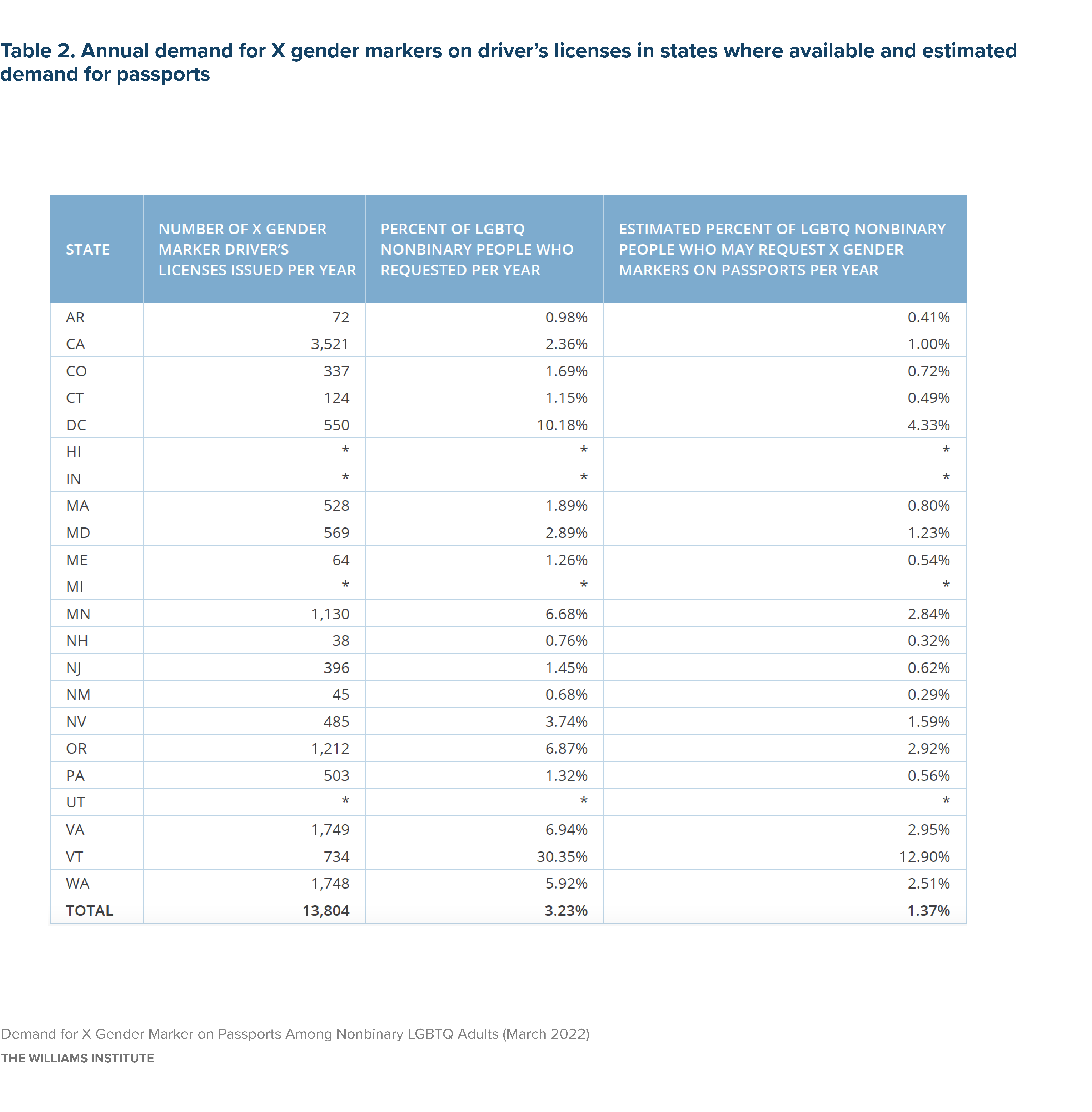In October 2021, the United States issued its first passport with an X gender marker. It has become one of just a few countries to provide that option, and follows 21 states and the District of Columbia, which currently allow X gender markers on driver’s licenses. An X gender marker is an option offered in addition to “M” for male and “F” for female. People with gender identities other than exclusively male or female, including those who identify as nonbinary, may want an X gender marker on their identity documents so that their IDs more accurately reflect their gender. Accurate identification documents are required for participation in many aspects of life, including voting and travel. Inaccurate IDs have been associated with discrimination and harassment, and possession of inaccurate IDs has been associated with higher rates of psychological distress among transgender adults. Prior research has found that individuals are more likely to be questioned by TSA officers if the gender marker on their passport is incorrect. The availability of X gender markers on passports will allow nonbinary people to have identity documents that more accurately reflect their gender, which may allow easier navigation of public spaces such as TSA checkpoints and may reduce instances of harassment and discrimination.
We estimate that 1.4% of the nonbinary LGBTQ population in the U.S., or 16,700 people, may request passports with an X gender marker each year. This estimate is based upon current demand for X gender markers on driver’s licenses in states which allow such an option.

Wilson, B. D. M. & Meyer, I. H. (2021). Nonbinary LGBTQ Adults in the United States. Los Angeles: The Williams Institute, UCLA. https://williamsinstitute.law.ucla.edu/publications/nonbinary-lgbtq-adults-us
Methods
The estimated demand for passports with X gender markers was created based upon the following:
1. The existing demand for X gender markers on driver’s licenses where available
2. The ratio between the possession of a driver’s license and the possession of a passport in the general population
3. The estimated population of nonbinary LGBTQ people ages 18-60 in the United States
Existing demand for X gender markers on driver’s licenses was assessed using data collected from states which offer this type of gender marker. The state licensing agencies that issue driver’s licenses in these states were contacted by the ACLU in the summer of 2021, and responses were received from 18 out of 21 states and the District of Columbia. The number of issued IDs with X gender markers was reported, as well as the time period during which X gender markers were available. The oldest policy with the most data available is in the District of Columbia, where X gender markers have been available on driver’s licenses since May of 2017. Years of data collected from these states varied from four years in D.C. to just three months in New Jersey. This information about the number of X gender markers issued was adjusted by the amount of time they were available and used to create the average number of driver’s licenses with X gender markers that have been issued per year.
Demand for driver’s licenses differs from demand for passports. Therefore, we “discounted” the demand for passports by the ratio of possession of a passport to the possession of a driver’s license in the U.S. general population. To identify the ratio of possession of a passport to possession of a driver’s license in the general population, the percentage of adults who have a valid and unexpired passport (37%) was divided by the percentage of the driving-age population which has a driver’s license (87%). This ratio, 0.425, was multiplied by the number of driver’s licenses with X gender markers issued each year to create an estimate of how many passports with X gender markers may be requested and issued each year.
The estimated number of nonbinary LGBTQ people in each state relies upon the estimated percent of the LGBTQ population ages 18-60 who identifies as nonbinary (11.1%). This percentage was multiplied by the estimated number of LGBTQ people in each state within that age range. The number of LGBTQ people in each state within the ages of 18-60 was created by multiplying the number of LGBT adults in each state by the percentage of LGBT adults who are 18-60. This percentage relies upon data from the Behavioral Risk Factor Surveillance System (BRFSS), years 2017-2020. State-specific estimates of this age group among LGBT people were used for states which included the Sexual Orientation and Gender Identity (SOGI) module in their BRFSS surveys, and ranged from 82.2%- 92.0%. The national percentage of LGBT people who are 18-60, 86.9%, was used for states which did not include the SOGI module in their BRFSS surveys between 2017 and 2020.
In summary, the average number of driver’s licenses with X gender markers issued per year in the 18 states with available data (13,804) was multiplied by 0.425 to create an estimate of how many passports with X gender markers may be requested and issued per year in these states (5,866). This estimated demand for passports with X gender markers in these 18 states was divided by the total population of nonbinary LGBTQ people ages 18-60 estimated to live in these states, to create an estimated percentage of nonbinary LGBTQ people who would request passports with an X gender marker per year (1.37%). 1.37% was multiplied by the total estimated number of nonbinary LGBTQ people ages 18-60 in the United States (1,219,000), to create an estimate of the number of passports with X gender markers that may be requested or issued per year (16,700).
We make several assumptions to complete our estimates. We assume that the demand for IDs with X gender markers for adults ages 18-60 is not substantially different from adults ages 61+. Our information about existing demand for driver’s licenses reflects demand from all adults, not just for ages 18-60. We assume that the proportion of LGBTQ people ages 18-60 in a state, which is the underlying population parameter for the nonbinary LGBTQ adult population estimate, is similar to the proportion of LGBT people ages 18-60 in a state as provided by BRFSS. We assume that the proportion of LGBTQ people ages 18-60 who are nonbinary does not vary by state. We assume that the ratio between the possession of a drivers’ license and possession of a passport in the general population is similar to the ratio among nonbinary LGBTQ people within this age group who may desire an X gender marker. Yet, it is possible that nonbinary LGBTQ people may be interested in a passport for purposes of having an accurate ID regardless of their travel plans. This may result in a higher demand for passports among nonbinary LGBTQ people as compared to the general population in states that do not currently offer X gender markers on driver’s licenses. Conversely, states where an X gender marker is already available on driver’s licenses may have lower demand for X gender markers on passports from nonbinary LGBTQ people who have already been issued a driver’s license with an X gender marker. Finally, we assume that demand for driver’s licenses with X gender markers as recorded by state licensing agencies is coming from nonbinary LGBTQ individuals, whereas demand may also come from those with other gender identities.
It is a limitation of our analysis that we do not have data available to consider those with different gender identities who may also desire an X gender marker. It is also a limitation of our study that we do not make estimates that reflect changes in demand for X gender markers over time. For instance, demand for this type of ID could be higher in the first year of implementation due to pent up demand, or it could be lower due to lack of knowledge of its availability. Due to variability in the time frames that X gender markers were available in the states that provided data, we are only able to provide a yearly average. Furthermore, this study did not account for changes in future demand for X gender markers, which could increase over time due to younger age groups being more likely than older age groups to identify as nonbinary.

*did not respond to data requests

